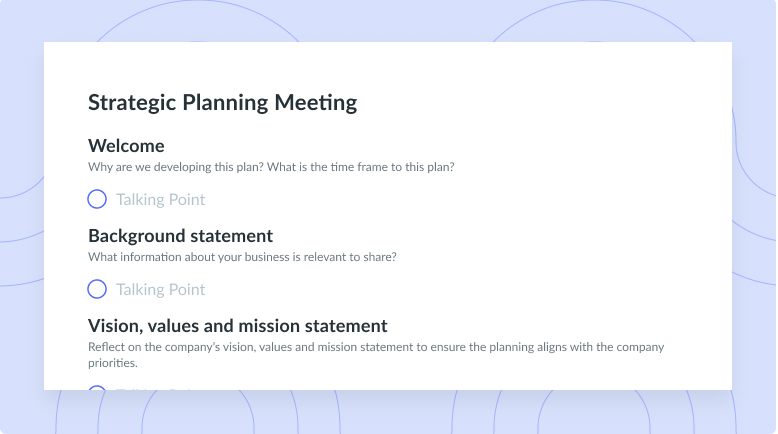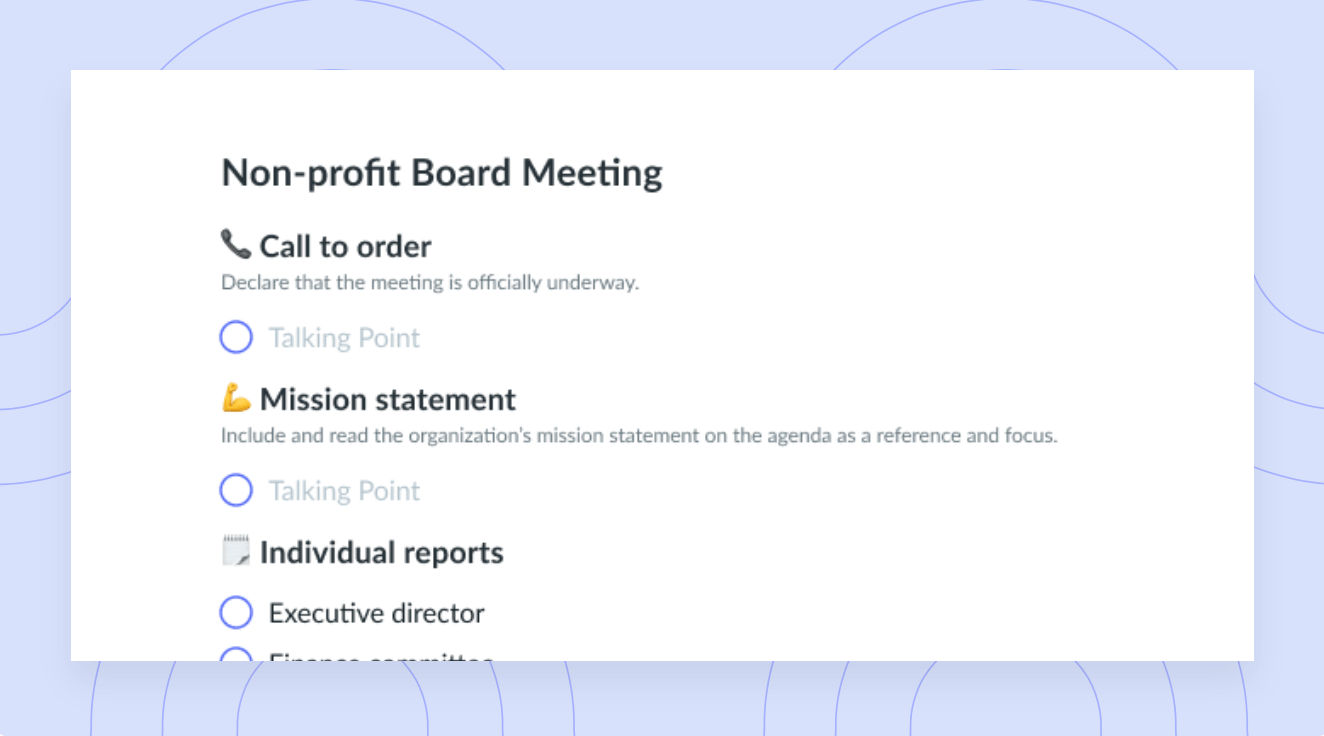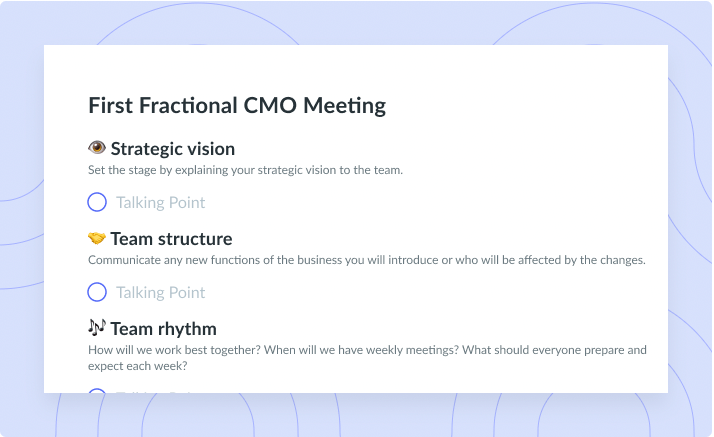Mission vs. Vision Statement: Definitions and Differences
Mission and vision statements aren’t the same thing. Discover what makes them different and find some examples of each.
It’s pretty easy to mix up mission and vision statements. In fact, some organizations might go so far as to use one statement in place of two separate ones. You’ll need both, though, to differentiate your organization from the competition and let potential customers and employees know what you have to offer. So to help you understand mission vs. vision statements, below are their definitions, their differences and similarities, and some examples to get you started.
- What is a mission statement?
- What is a vision statement?
- Mission statements vs. vision statements
- Mission statement questions
- Vision statement questions
- Mission statement and vision statement examples
What is a mission statement?
A mission statement focuses on the values at the heart of your organization. It’s the reason or the purpose behind your organization. It’s the “what” and “how” behind your organization in the present. You should center it around what’s happening right now and what your organization currently does. A typical mission statement is at most a few sentences long – just enough to help people understand what you’re all about.

Set clear mission and vision statements
Set clear mission and vision statements with a collaborative meeting agenda to ensure everyone is on the same page. Try a tool like Fellow today!

What is a vision statement?
A vision statement focuses on your hopes and dreams for the future. If a mission statement focuses on today, then a vision statement focuses on tomorrow. It’s where you hope to see your organization in five years, what it’ll be doing then, and the impact you want it to have.
Mission statements vs. vision statements
Below is a full breakdown of mission vs. vision statements – their differences and similarities.
1Differences between mission vs. vision statements
- Reason. While the mission and vision statements are both rooted in the company’s goals and core values, they each have a slightly different purpose. The mission statement shows your organization’s “what” and “how.” The vision statement, on the other hand, sticks to the “why.”
- Timing. A major difference between mission and vision statements is their timeframes. The mission statement is your guide for what’s happening right now, which can help lead you to where you want to be (the vision statement). They work together and share the common goal of making your organization successful across the board. But they’re focused on two different timeframes — the present and the future.
- Audience. Who are you speaking to with each of these statements? Well, usually, the mission statement is more public-facing, so it’s perfect for a customer-centric company. It’s also great for job applicants who want to learn about your organization. The vision statement is more internal and directed at existing employees and the company’s stakeholders. This way, your team knows what they’re working toward when they complete day-to-day tasks.
2Similarities between mission vs. vision statements
- Key to directing goals. Both statements play a huge part in guiding the goals of your organization. For example, if your organization’s goal is to provide the most reliable local transportation services in your area, your mission and vision statements should align with that. And they can both pave the way forward.
- Show an organization’s values. Mission and vision statements can help define your company since your organization’s values are the foundation of each statement. Both statements give a better idea of how you’re demonstrating your values now – and where you plan on taking them in the future.
- Help define your organization. For either statement to be successful, you need to understand each and every little thing about your organization. You need to know the who, what, why, when, where, and how of it all. This way, you can show customers and stakeholders how your organization thinks and what it can do for them.
Mission statement questions
When writing a mission statement, the below questions can point you and your team in the right direction. Make sure your company’s mission statement answers the following questions.
1What do we do?
Ask yourself an obvious question: What do we do here at this organization? If you sell reliable tires for a range of antique vehicles, then make that clear in your mission statement. Think about it like this: If you can’t clearly state what you do, then how will your customers figure it out?
2Who are our customers?
Now, you have the what, but to whom are you offering your products and services? If you’re focused on vintage cars, then you’re selling to people who own, collect or sell vintage cars. This is important because, for the statement to be successful, you have to keep the right people in mind. You have to speak directly to your customers to help build that precious customer loyalty.
3How do we meet our customers’ needs?
Ask yourself: How are you providing vintage car owners and people who love old car companies with the most reliable tires? Make sure you’re clear about the how in the mission statement to give a complete picture of what you do and how you do it.
For example, maybe your “how” for this scenario is that, after being a collector yourself, you’ve found the best resources for sourcing tires. Through your connections and experience, you’re able to give customers the best tires at the best price.
Vision statement questions
Here are three questions to ask and answer as you write your vision statement.
- What are our desires and plans?
- What problems do we solve?
- Who and what are we determined to evolve or reform?
1What are our desires and plans?
Since the vision statement is all about what you’re working toward and hoping to achieve, this question simply asks you to make those dreams clear. For instance, if you sell tires for vintage car collectors at a reasonable price, then where do you hope to take that mission? Are you looking to give collectors more of a space to explore their interests? What about encouraging new collectors to get involved in the hobby?
2What problems do we solve?
Sure, you might have the most amazing tires on the market, but what problem are you solving? Maybe you’re working to make vintage car collecting more accessible to anyone with a passion for it. Maybe right now, it’s a very limited and exclusive world, and you want to tear down those barriers.
3Who and what are we determined to evolve or reform?
A growth mindset is important, and it’s largely about knowing what you’re working to improve and whom you’re serving. For example, are you trying to revitalize the vintage car market? Is the specific area vintage cars or all rare cars, and what time period is vintage to you? Is it all vintage cars or specific makes and models? Are you inspiring the vintage car community to be more welcoming and inclusive?
Mission statement and vision statement examples
Here, you’ll find real-world examples of mission and vision statements from well-known companies.
1Patagonia
Mission statement: “We’re in business to save our home planet.”
Vision statement: “A love of wild and beautiful places demands participation in the fight to save them, and to help reverse the steep decline in the overall environmental health of our planet.”
Patagonia’s mission statement clearly answers the “what” and the “who” (everyone on the planet). The vision statement goes into detail about the dreams, problems, and specifics of what they want to change.
2Google
Mission statement: “To organize the world’s information and make it universally accessible and useful.”
Vision statement: “To provide access to the world’s information in one click.”
Google answers the current “what” (“organize the world’s information”) and the “who” (which implies everyone). And they define the “how” as making information accessible for everyone to reach those objectives. The vision statement shows Google’s dream of just how accessible they want to make information online.
3JetBlue
Mission statement: “JetBlue’s mission is to inspire humanity — both in the air and on the ground. We are committed to giving back in meaningful ways in the communities we serve and to inspire others to do the same.”
Vision statement: “JetBlue’s vision is one of continual emphasis on providing competitive rates for customers for all of our destinations.”
JetBlue’s mission statement answers the “what” (providing inspiration “in the air and on the ground”) and the “who” (all people). They answer the “how” via the sentiment of giving back in meaningful ways. Their vision statement hints at solving the problem of good prices for all destinations.
4IKEA
Mission: “Offer a wide range of well-designed, functional home furnishing products at prices so low that as many people as possible will be able to afford them.”
Vision: “To create a better everyday life for the many people.”
For Ikea, the “what” and the “who” is addressed in the mission statement, as well as the “how.” They provide furniture at low prices to serve as many people as possible. The vision statement is broad and aspirational, but it still looks toward the future – and leaves it open-ended.
Create your mission and vision statements with your team
Your organization’s mission and vision statements make your values clear to your customers and your team. A meeting can be a great place to brainstorm and develop your mission and vision statements. With Fellow, it’s easier than ever to host productive and efficient team meetings. You can use Fellow to build collaborative meeting agendas and record decisions. This way, you can easily keep track of all the brilliant ideas flying around the room.





![Improving Your Strategic Thinking Skills: 10 Tips [+Example]](https://fellow.app/wp-content/uploads/2023/05/strategic-thinking-skills2.jpg)






















